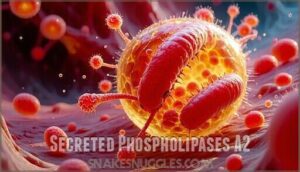This site is supported by our readers. We may earn a commission, at no cost to you, if you purchase through links.

Viper venom hemotoxic properties target your blood’s clotting system like a molecular wrecking ball, disrupting normal hemostasis through three main toxin families.
Phospholipases A2 break down cell membranes, while metalloproteinases and serine proteases attack your blood vessels and clotting factors.
This toxic cocktail can cause severe bleeding, tissue damage, and cardiovascular collapse.
Think of it as your body’s plumbing system under assault—pipes burst, repairs fail, and chaos ensues.
Understanding these mechanisms isn’t just academic curiosity; it’s the key to discovering life-saving treatments and revolutionary medical therapies.
Table Of Contents
- Key Takeaways
- What Are The Properties of Viper Venom?
- Is Viper Venom Hemotoxic?
- Hemotoxic Effects of Viper Venom
- Variability in Viper Venom Hemotoxicity
- Therapeutic Implications of Viper Venom Hemotoxins
- Understanding Viper Venom’s Impact on Hemostasis
- Snake Venom Toxins Targeting Hemostasis
- Managing Viper Snakebite With Hemotoxic Venom
- Investigating Viper Venom’s Role in Haemodynamic Effects
- Future Research Directions for Viper Venom Hemotoxins
- Frequently Asked Questions (FAQs)
- What are the properties of viper venom?
- Is viper venom hemotoxic?
- What are the hemotoxic effects of snake venom?
- What are the features of hemotoxic snake bite?
- How does viper venom hemotoxicity compare to other snake families?
- Can viper venom hemotoxins be neutralized by natural compounds?
- How do environmental conditions affect viper venom hemotoxicity?
- Are there genetic markers for resistance to viper hemotoxins?
- How quickly does viper venom cause bleeding?
- Can children survive severe viper venom hemotoxicity?
- Conclusion
Key Takeaways
- You’re dealing with nature’s most sophisticated blood-destroying weapon when bitten by a viper – their venom contains over 100 proteins that systematically dismantle your blood’s clotting system through three main toxin families: phospholipases A2, metalloproteinases, and serine proteases.
- You’ll experience devastating hemotoxic effects including uncontrolled bleeding, tissue destruction, and cardiovascular collapse as the venom triggers venom-induced coagulopathy where your blood either won’t clot at all or clots uncontrollably throughout your system.
- You can’t rely on a one-size-fits-all treatment approach because viper venom composition varies dramatically between species and geographic regions – what works against one population’s venom might fail completely against another’s, making proper antivenom selection critical for survival.
- You’re witnessing deadly toxins becoming life-saving medicines as researchers transform viper venom components into FDA-approved drugs like Captopril for hypertension and Tirofiban for blood clot prevention, proving that understanding these hemotoxic mechanisms creates breakthrough therapeutic opportunities.
What Are The Properties of Viper Venom?
How devastating can a single bite really be? Viper venom represents nature’s most sophisticated biochemical weapon, containing over 100 different proteins designed to incapacitate prey instantly.
You’re dealing with a complex cocktail where venom composition varies dramatically between species, creating unique fingerprints of toxicity. Toxin delivery occurs through specialized fangs that inject concentrated doses directly into tissue, maximizing effectiveness.
Nature’s most sophisticated biochemical weapon delivers over 100 different proteins through precision-engineered fangs.
Venom evolution has fine-tuned these hemotoxic properties over millions of years, with venom potency reaching lethal concentrations in microscopic amounts.
Geographic variation means the same species can produce dramatically different snake venom profiles depending on location. This hemotoxic venom targets your blood cells, clotting mechanisms, and vascular system simultaneously.
Understanding venom toxicity helps explain why viper venom causes such rapid, devastating effects throughout your circulatory system.
Is Viper Venom Hemotoxic?
Having explored viper venom’s general properties, you’re probably asking yourself: **Is viper venom truly hemotoxic?
**Absolutely.
** Viper venom stands as nature’s most efficient blood destroyer, targeting your circulatory system with surgical precision.
Hemotoxic venom doesn’t just damage blood—it systematically dismantles your body’s ability to maintain proper circulation.
This snake venom triggers venom-induced coagulopathy, where your blood either clots uncontrollably or refuses to clot at all.
Internal bleeding mechanisms activate throughout your system, while red blood cell damage occurs on a massive scale.
The venom toxicity extends beyond blood destruction.
Tissue necrosis factors begin breaking down healthy tissue around the bite site, creating wounds that won’t heal properly.
Hemorrhage severity factors determine whether you’ll experience minor bleeding or life-threatening blood loss.
Understanding hemotoxicity helps explain why viper bites prove so dangerous—and why swift medical intervention remains your best defense against these blood-targeting toxins.
Hemotoxic Effects of Viper Venom
When a viper strikes and injects its venom into your bloodstream, you’re experiencing one of nature’s most efficient blood-destroying mechanisms in action.
Nature’s liquid assassin floods your veins, systematically dismantling every defense your blood system desperately tries to mount.
The hemotoxic components in viper venom immediately begin attacking your red blood cells, disrupting clotting factors, and triggering widespread internal bleeding that can prove fatal within hours if left untreated.
Secreted Phospholipases A2
You now understand viper venom’s hemotoxic nature, but secreted phospholipases A2 (sPLA2s) deserve special attention.
These enzymes attack cell membrane phospholipids, triggering inflammation and tissue destruction.
sPLA2 diversity across snake species creates different hemotoxic profiles, while sPLA2 mechanisms involve complex pathways affecting blood coagulation.
sPLA2 evolution has produced various isoforms with distinct functions.
Researchers study sPLA2 inhibitors as potential treatments for viper envenomation and related medical conditions.
Snake Venom Metalloproteinases
Among viper venom’s deadliest components, snake venom metalloproteinases (SVMPs) act like molecular scissors, systematically dismantling your blood’s protective mechanisms.
These metalloproteinases showcase remarkable SVMP diversity and evolution, making hemotoxic venom particularly dangerous.
SVMP structure enables precise targeting, while SVMP function creates chaos through:
- Shredding blood vessel walls like tissue paper
- Sabotaging platelet cooperation completely
- Hijacking your clotting system maliciously
- Destroying fibrinogen mercilessly throughout circulation
SVMP inhibition remains challenging, requiring targeted hemotoxicity mechanism understanding, and this challenge is due to the molecular scissors-like action of SVMPs, which makes them highly effective at dismantling the blood’s protective mechanisms.
Snake Venom Serine Proteases
How do snake venom serine proteases wreak havoc on your blood?
These enzymes directly attack your coagulation cascade, preventing normal clotting. SVSP diversity varies dramatically between species, while SVSP evolution has refined their deadly efficiency.
Understanding SVSP structure reveals how these hemotoxic venom components cause devastating bleeding disorders in viper envenomation victims.
| SVSP Characteristic | Impact on Blood |
|---|---|
| Enzyme Activity | Disrupts clotting factors |
| Target Specificity | Attacks fibrinogen directly |
| Evolutionary Origin | Refined over millions of years |
| Clinical Effect | Causes uncontrolled bleeding |
Variability in Viper Venom Hemotoxicity
You’ve seen how viper venom wreaks havoc on blood, but here’s where things get really interesting: not all vipers are created equal. Venom variability means you’re dealing with a biological lottery where Geographic Variation plays a huge role.
A Russell’s viper from Thailand might pack completely different hemotoxic properties than its cousin from India. Ontogenetic Shifts add another layer of complexity—young snakes often produce different toxin cocktails than adults.
Venom Potency can vary dramatically based on diet, with Prey Specificity shaping which Toxin Isoforms dominate. Some populations load up on snake venom metalloproteinases that cause massive bleeding, while others favor phospholipases that destroy cell membranes.
This haemotoxicity variation isn’t just academic curiosity—it’s life-or-death information. Viper venom from different regions requires different antivenom formulations. What works against one population might fail spectacularly against another.
Understanding these patterns helps doctors choose the right treatment and explains why snakebite outcomes vary so dramatically across different geographic regions.
Therapeutic Implications of Viper Venom Hemotoxins
You might find it surprising that the same venom components causing deadly bleeding can actually become powerful therapeutic tools when properly harnessed by medical researchers.
Scientists have successfully transformed several viper venom hemotoxins into approved medications and promising drug candidates, proving that nature’s most dangerous substances can become life-saving treatments.
Approved Drugs
Nature’s deadliest toxins have become lifesaving approved drugs with remarkable drug efficacy.
Six FDA-approved venom-derived drugs transform viper venom‘s hemotoxic properties into therapeutic gold:
- Captopril – First venom-based drug treating hypertension since 1981
- Tirofiban – Antiplatelet medication from viper venom compounds
- Eptifibatide – Blood clot prevention derived from rattlesnake venom
- Batroxobin – Anticoagulant therapy for thrombotic disorders
These breakthrough treatments prove that understanding venomous mechanisms creates alternative therapies while reducing treatment costs compared to traditional medications.
Other venomous creatures, like the Gila monster, have also contributed to such medications.
Drugs in Preclinical and Clinical Trials
How are researchers transforming deadly venom into life-saving medicine?
Drug discovery teams are conducting preclinical trials on venom-derived compounds targeting blood disorders.
Clinical trials evaluate hemotoxic properties for therapeutic applications, while target validation studies confirm safety profiles.
Trial design focuses on regulatory pathways for FDA approval.
| Trial Phase | Compound Focus | Target Condition |
|---|---|---|
| Preclinical | Phospholipase A2 | Cardiovascular disease |
| Phase I | Metalloproteinases | Blood clotting disorders |
| Phase II | Serine proteases | Stroke prevention |
| Phase III | ACE inhibitors | Hypertension treatment |
| Regulatory | Multi-compound | Cancer therapy |
Clinical efficacy shows promising results for these venom-derived drugs.
Researchers are exploring how RVV-X activates Factor X for hemophilia treatment.
Understanding Viper Venom’s Impact on Hemostasis
While therapeutic applications show promise, viper venom’s assault on your body’s hemostatic system reveals nature’s most sophisticated biological weapon.
When viper venom enters your bloodstream, it orchestrates a deadly symphony of hemotoxic properties that systematically dismantles your blood coagulation mechanisms.
The venom triggers platelet dysfunction, preventing your blood cells from forming proper clots when you need them most.
Simultaneously, it causes microvascular thrombosis, creating dangerous blockages in your smallest blood vessels.
This creates venom-induced coagulopathy, where your blood can’t clot normally, leading to uncontrolled haemorrhage.
Regional variations in venom composition mean that different viper species affect hemostasis in unique ways.
Some venoms primarily attack clotting factors, while others focus on destroying platelets.
This complexity explains why antivenom limitations persist – what works against one species may fail against another, making effective treatment challenging.
Immediate access to hemotoxic snake antivenom is essential for survival after a viper bite.
Snake Venom Toxins Targeting Hemostasis
Viper venom contains a deadly arsenal of toxins that systematically attack your blood’s clotting system.
These hemotoxic properties make each bite potentially life-threatening through multiple hemorrhage mechanisms.
When snake venom enters your bloodstream, specific toxins target different aspects of hemostasis:
- Snake venom metalloproteinases (SVMPs) – These proteins destroy blood vessel walls and trigger massive hemorrhage throughout your body
- Snake venom serine proteases (SVSPs) – They manipulate coagulation factors, creating venom-induced coagulopathy that prevents proper clotting
- Phospholipases A2 (PLA2s) – These enzymes cause fibrinolysis disruption while damaging cell membranes and red blood cells
- C-type lectin-like proteins – They interfere with platelet aggregation, making it impossible for your blood to form protective clots
Some toxins act as anticoagulant toxins, while others paradoxically trigger excessive clotting.
This dual assault overwhelms your body’s natural hemostatic balance, creating a perfect storm of bleeding complications.
The study of venom proteomes is essential for understanding these effects.
Managing Viper Snakebite With Hemotoxic Venom
Understanding how viper venom targets your blood system sets the stage for effective snakebite treatment.
When hemotoxicity strikes, you’re racing against time to prevent devastating complications like tissue necrosis and kidney injury.
Your primary weapon is antivenom efficacy, which depends on rapid administration within four hours of the bite.
Focus on bleeding control through immediate coagulation management while monitoring for signs of internal hemorrhaging.
Snake venom attacks your blood’s clotting mechanisms, so you’ll need aggressive fluid replacement and fresh frozen plasma if coagulopathy develops.
Remember, successful snakebite treatment requires recognizing early symptoms and acting decisively before viper venom overwhelms your body’s natural defenses.
To acquire viper antivenom treatment, explore available options.
Investigating Viper Venom’s Role in Haemodynamic Effects
When viper venom enters your bloodstream, it triggers a cascade of haemodynamic effects that can quickly turn deadly.
The venom’s metalloproteinases and phospholipases A2 attack your blood vessel walls, causing internal hemorrhaging and red blood destruction throughout your circulatory system.
You’ll experience dramatic blood pressure drops as venom-induced coagulopathy disrupts your body’s clotting mechanisms.
The toxins increase vascular permeability, allowing blood to leak from damaged capillaries while simultaneously triggering widespread coagulopathy.
This creates a perfect storm where you’re bleeding internally while your blood can’t clot properly.
The haemotoxicity doesn’t stop there.
As venom spreads, it causes tissue necrosis at the bite site and can lead to kidney injury from systemic effects.
Your cardiovascular system struggles to maintain proper circulation as haemorrhage and shock set in, making immediate medical intervention vital for survival.
Future Research Directions for Viper Venom Hemotoxins
Revolutionary breakthroughs in venom research directions are reshaping how you’ll approach hemotoxin studies.
You’ll discover that personalized antivenomics will tailor treatments based on individual patient responses and regional venom variations.
Advanced venom proteomics research will help you identify novel anticoagulants with therapeutic potential, while sophisticated hemorrhage biomarkers will enable faster diagnosis of envenomation severity.
Your future investigations into venom evolution will reveal how environmental pressures shape toxin profiles across different populations.
You’ll explore therapeutic targets within hemotoxin pathways, potentially developing breakthrough medications for cardiovascular diseases.
Cutting-edge venom composition research will uncover synergistic interactions between toxin families that weren’t previously understood.
A key concern is acute renal failure following envenomation.
Through exhaustive toxin evolution research, you’ll map the molecular mechanisms driving venom diversification.
This knowledge will accelerate antivenom development research, creating more effective treatments with fewer side effects.
Each discovery brings you closer to transforming deadly toxins into life-saving medicines.
Frequently Asked Questions (FAQs)
What are the properties of viper venom?
When you encounter viper venom, you’re facing complex protein mixtures that’ll wreak havoc on your blood system.
These toxins cause immediate coagulation disorders, destroy red blood cells, trigger hemorrhaging, and create painful tissue necrosis at bite sites.
Is viper venom hemotoxic?
Like liquid fire coursing through your bloodstream, yes, you’ll find that viper venom is definitely hemotoxic.
It attacks red blood cells, triggers bleeding disorders, and causes coagulopathy that can be life-threatening.
What are the hemotoxic effects of snake venom?
When you’re bitten by hemotoxic snakes, you’ll experience blood cell destruction, coagulation disorders, and internal bleeding.
Your tissues suffer immediate damage and necrosis, while kidney injury often follows from widespread hemorrhaging effects, leading to internal bleeding.
What are the features of hemotoxic snake bite?
Think of your blood as a well-oiled machine suddenly thrown into chaos.
You’ll experience rapid clotting disorders, internal bleeding, tissue destruction at the bite site, and potential kidney damage from widespread circulatory disruption, including rapid clotting disorders and internal bleeding.
How does viper venom hemotoxicity compare to other snake families?
Viper venoms excel at destroying blood cells and triggering coagulopathy, while cobras primarily attack your nervous system and coral snakes cause paralysis.
You’ll face different challenges depending on which family bites you.
Can viper venom hemotoxins be neutralized by natural compounds?
Don’t count your chickens before they hatch—while plant compounds like flavonoids and polyphenols can neutralize some hemotoxins, they’re not reliable standalone treatments.
You’ll still need proper medical antivenom for effective protection.
How do environmental conditions affect viper venom hemotoxicity?
Temperature and humidity directly impact your exposure risk to hemotoxic viper venoms. You’ll face increased venom potency in warmer conditions, while cooler temperatures reduce toxin activity and hemorrhagic effects substantially.
Are there genetic markers for resistance to viper hemotoxins?
Research shows approximately 8 million people face venomous snakebites annually, yet you’re not defenseless.
While no specific genetic markers for hemotoxin resistance exist in humans, some populations show inherited variations affecting venom metabolism and recovery rates.
How quickly does viper venom cause bleeding?
You’ll experience bleeding within minutes of a viper bite.
The hemotoxic venom rapidly destroys blood cells and triggers coagulopathy, causing immediate internal hemorrhaging and consumptive coagulopathy that attacks your clotting system, leading to coagulopathy.
Can children survive severe viper venom hemotoxicity?
Time is of the essence when children face severe viper venom hemotoxicity.
You’ll find survival depends on rapid antivenom treatment, medical intervention, and supportive care targeting bleeding, coagulopathy, and organ damage within critical hours, which emphasizes the importance of rapid action.
Conclusion
Can you imagine how three simple toxin families create such devastating effects on human blood?
Understanding viper venom hemotoxic properties reveals nature’s most sophisticated biological weapons system.
You’ve seen how phospholipases A2, metalloproteinases, and serine proteases work together to disrupt hemostasis completely.
These discoveries aren’t just fascinating science—they’re driving breakthrough medical treatments for stroke, heart disease, and bleeding disorders.
Future research will reveal even more therapeutic potential from these deadly yet remarkable molecular mechanisms.
- https://www.sciencedirect.com/topics/pharmacology-toxicology-and-pharmaceutical-science/viper-venom
- https://animalresearcher.com/what-makes-vipers-so-dangerous-and-unique-among-venomous-snakes/
- https://pmc.ncbi.nlm.nih.gov/articles/PMC9917609/
- https://www.biotechreality.com/2023/10/russells-viper-hemotoxic-venom-details-types-effects-and-pharmacology.html
- https://wildlifeinformer.com/types-of-snake-venom/
















